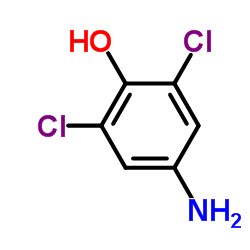4-Amino-2,6-dichlorophenol

4-Amino-2,6-dichlorophenol structure
|
Common Name | 4-Amino-2,6-dichlorophenol | ||
|---|---|---|---|---|
| CAS Number | 5930-28-9 | Molecular Weight | 178.016 | |
| Density | 1.6±0.1 g/cm3 | Boiling Point | 303.6±42.0 °C at 760 mmHg | |
| Molecular Formula | C6H5Cl2NO | Melting Point | 167-170 °C(lit.) | |
| MSDS | USA | Flash Point | 137.4±27.9 °C | |
| Symbol |

GHS07 |
Signal Word | Warning | |
|
Characterization of methemoglobin formation induced by 3,5-dichloroaniline, 4-amino-2,6-dichlorophenol and 3,5-dichlorophenylhydroxylamine.
Toxicology 118(1) , 23-36, (1997) 3,5-Dichloroaniline is an intermediate in the production of certain fungicides. This study characterized the capacity of 3,5-dichloroaniline and two putative metabolites to induce methemoglobin formation. In vivo intraperitoneal (i.p.) administration of 0.8 m... |
|
|
Fluorescent materials for pH sensing and imaging based on novel 1,4-diketopyrrolo-[3,4-c]pyrrole dyes†Electronic supplementary information (ESI) available: NMR and MS spectra, further sensor characteristics and sensor long-time performance. See DOI: 10.1039/c3tc31130aClick here for additional data file.
J. Mater. Chem. C 1 , 5685-5693, (2013) New optical pH-sensors relying on 1,4-diketopyrrolo-[3,4-c]pyrroles (DPPs) as fluorescent pH-indicators are presented. Different polymer hydrogels are useful as immobilization matrices, achieving excellent sensitivity and good brightness in the resulting sens... |
|
|
Theory and practice of enzyme bioaffinity electrodes. Chemical, enzymatic, and electrochemical amplification of in situ product detection.
J. Am. Chem. Soc. 130(23) , 7276-85, (2008) The two articles in this series are dedicated to bioaffinity electrodes with in situ detection of the product of the enzyme label after recognition by its conjugate immobilized on the electrode. Part 1 was devoted to direct electrochemical detection, whereas ... |
|
|
Theory and practice of enzyme bioaffinity electrodes. Direct electrochemical product detection.
J. Am. Chem. Soc. 130(23) , 7259-75, (2008) The use of enzyme labeling techniques to convert biorecognition events into high sensitivity electrochemical signals may follow two different strategies. One, in which the current is the electrocatalytic response of a redox couple serving as cosubstrate to a ... |
|
|
In vivo and in vitro 4-amino-2,6-dichlorophenol nephrotoxicity and hepatotoxicity in the Fischer 344 rat.
Toxicology 90(1-2) , 115-28, (1994) Halogenated anilines and aminophenols are nephrotoxicants and hepatotoxicants in mammals. The purpose of this study was to determine the in vivo and in vitro nephrotoxic and hepatotoxic potential of 4-amino-2,6-dichlorophenol, a putative metabolite of 3,5-dic... |
|
|
4-Amino-2,6-dichlorophenol nephrotoxicity in the Fischer 344 rat: protection by ascorbic acid, AT-125, and aminooxyacetic acid.
Toxicol. Appl. Pharmacol. 147(1) , 115-25, (1997) A halogenated derivative of 4-aminophenol, 4-amino-2, 6-dichlorophenol (ADCP), is a potent nephrotoxicant and a weak hepatotoxicant in Fischer 344 rats. Although the mechanism of ADCP nephrotoxicity is unknown, ADCP could undergo oxidation to a reactive inter... |
|
|
Mechanistic aspects of 4-amino-2,6-dichlorophenol-induced in vitro nephrotoxicity.
Toxicology 245(1-2) , 123-9, (2008) 4-Amino-2,6-dichlorophenol (ADCP) is a potent acute nephrotoxicant in vivo inducing prominent renal corticomedullary necrosis. In vitro, ADCP exposure increases lactate dehydrogenase (LDH) release from rat renal cortical slices at 0.05 mM or greater. The purp... |